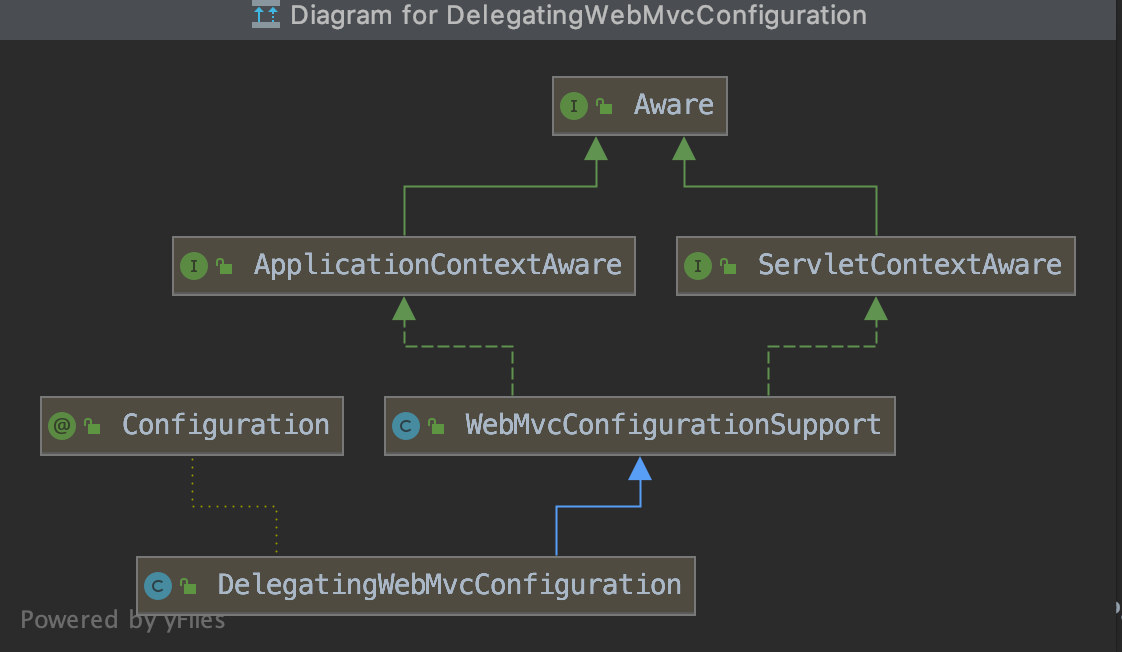SpringWeb 拦截器
前言
spring拦截器能帮我们实现验证是否登陆、验签校验请求是否合法、预先设置数据等功能,那么该如何设置拦截器以及它的原理如何呢,下面将进行简单的介绍
1.设置
HandlerInterceptor接口
public interface HandlerInterceptor {
/**
* Intercept the execution of a handler. Called after HandlerMapping determined
* an appropriate handler object, but before HandlerAdapter invokes the handler.
* <p>DispatcherServlet processes a handler in an execution chain, consisting
* of any number of interceptors, with the handler itself at the end.
* With this method, each interceptor can decide to abort the execution chain,
* typically sending a HTTP error or writing a custom response.
* <p><strong>Note:</strong> special considerations apply for asynchronous
* request processing. For more details see
* {@link org.springframework.web.servlet.AsyncHandlerInterceptor}.
* <p>The default implementation returns {@code true}.
* @param request current HTTP request
* @param response current HTTP response
* @param handler chosen handler to execute, for type and/or instance evaluation
* @return {@code true} if the execution chain should proceed with the
* next interceptor or the handler itself. Else, DispatcherServlet assumes
* that this interceptor has already dealt with the response itself.
* @throws Exception in case of errors
*/
default boolean preHandle(HttpServletRequest request, HttpServletResponse response, Object handler)
throws Exception {
return true;
}
/**
* Intercept the execution of a handler. Called after HandlerAdapter actually
* invoked the handler, but before the DispatcherServlet renders the view.
* Can expose additional model objects to the view via the given ModelAndView.
* <p>DispatcherServlet processes a handler in an execution chain, consisting
* of any number of interceptors, with the handler itself at the end.
* With this method, each interceptor can post-process an execution,
* getting applied in inverse order of the execution chain.
* <p><strong>Note:</strong> special considerations apply for asynchronous
* request processing. For more details see
* {@link org.springframework.web.servlet.AsyncHandlerInterceptor}.
* <p>The default implementation is empty.
* @param request current HTTP request
* @param response current HTTP response
* @param handler handler (or {@link HandlerMethod}) that started asynchronous
* execution, for type and/or instance examination
* @param modelAndView the {@code ModelAndView} that the handler returned
* (can also be {@code null})
* @throws Exception in case of errors
*/
default void postHandle(HttpServletRequest request, HttpServletResponse response, Object handler,
@Nullable ModelAndView modelAndView) throws Exception {
}
/**
* Callback after completion of request processing, that is, after rendering
* the view. Will be called on any outcome of handler execution, thus allows
* for proper resource cleanup.
* <p>Note: Will only be called if this interceptor"s {@code preHandle}
* method has successfully completed and returned {@code true}!
* <p>As with the {@code postHandle} method, the method will be invoked on each
* interceptor in the chain in reverse order, so the first interceptor will be
* the last to be invoked.
* <p><strong>Note:</strong> special considerations apply for asynchronous
* request processing. For more details see
* {@link org.springframework.web.servlet.AsyncHandlerInterceptor}.
* <p>The default implementation is empty.
* @param request current HTTP request
* @param response current HTTP response
* @param handler handler (or {@link HandlerMethod}) that started asynchronous
* execution, for type and/or instance examination
* @param ex exception thrown on handler execution, if any
* @throws Exception in case of errors
*/
default void afterCompletion(HttpServletRequest request, HttpServletResponse response, Object handler,
@Nullable Exception ex) throws Exception {
}
}自定义拦截器需要实现HandlerInteceptor接口,该接口有三个方法:
preHandle:主要在映射适配器执行handler之前调用,若返回为true则继续往下执行handler,若返回为false则直接返回不继续处理请求
postHandle:主要在适配器执行handler之后调用
afterCompletion:在postHandle后调用可清理一些数据,若preHandle返回false那么会调用完此方法后再返回
@Component
@Slf4j(topic = "e")
public class CustomInterceptor implements HandlerInterceptor {
@Override
public boolean preHandle(HttpServletRequest request, HttpServletResponse response, Object handler)
throws Exception {
log.info("-------------拦截请求:" + request.getRequestURI() + "-------------");
// 可以根据request设置请求头、或从请求头提取信息等等...
return true;
}
@Override
public void postHandle(HttpServletRequest request, HttpServletResponse response, Object handler,
@Nullable ModelAndView modelAndView) throws Exception {
log.info("postHandle ....");
}
@Override
public void afterCompletion(HttpServletRequest request, HttpServletResponse response, Object handler,
@Nullable Exception ex) throws Exception {
log.info("afterCompletion ....");
}
}接着创建配置类,实现WebMvcConfigurer接口,重写addInterceptors方法将自定义拦截器添加,并且加上@EnableWebMvc注解 (springboot项目会自动配置)
@Configuration
@EnableWebMvc
public class MyMvcConfigurer implements WebMvcConfigurer {
@Resource
private CustomInterceptor customInterceptor;
@Override
public void addInterceptors(InterceptorRegistry registry) {
registry.addInterceptor(customInterceptor)
.addPathPatterns("/**");
}
}配置完之后启动项目访问某个url路径,从控制台可以看到拦截器确实生效了

2.原理
首先是@EnableWebMvc注解,spring会解析并导入DelegatingWebMvcConfiguration这个bean,继承关系如下,主要逻辑都写在父类WebMvcConfigurationSupport中
@Retention(RetentionPolicy.RUNTIME)
@Target(ElementType.TYPE)
@Documented
@Import(DelegatingWebMvcConfiguration.class)
public @interface EnableWebMvc {
}
WebMvcConfigurationSupport中会创建一个映射处理器RequestMappingHandlerMapping
@Bean
public RequestMappingHandlerMapping requestMappingHandlerMapping() {
RequestMappingHandlerMapping mapping = createRequestMappingHandlerMapping();
mapping.setOrder(0);
// 设置拦截器到mapping
mapping.setInterceptors(getInterceptors());
// 设置内容协商管理器
mapping.setContentNegotiationManager(mvcContentNegotiationManager());
// 跨域配置
mapping.setCorsConfigurations(getCorsConfigurations());
// 路径匹配设置
PathMatchConfigurer configurer = getPathMatchConfigurer();
Boolean useSuffixPatternMatch = configurer.isUseSuffixPatternMatch();
if (useSuffixPatternMatch != null) {
mapping.setUseSuffixPatternMatch(useSuffixPatternMatch);
}
Boolean useRegisteredSuffixPatternMatch = configurer.isUseRegisteredSuffixPatternMatch();
if (useRegisteredSuffixPatternMatch != null) {
mapping.setUseRegisteredSuffixPatternMatch(useRegisteredSuffixPatternMatch);
}
Boolean useTrailingSlashMatch = configurer.isUseTrailingSlashMatch();
if (useTrailingSlashMatch != null) {
mapping.setUseTrailingSlashMatch(useTrailingSlashMatch);
}
UrlPathHelper pathHelper = configurer.getUrlPathHelper();
if (pathHelper != null) {
mapping.setUrlPathHelper(pathHelper);
}
PathMatcher pathMatcher = configurer.getPathMatcher();
if (pathMatcher != null) {
mapping.setPathMatcher(pathMatcher);
}
return mapping;
}
#获取拦截器
protected final Object[] getInterceptors() {
if (this.interceptors == null) {
InterceptorRegistry registry = new InterceptorRegistry();
// 调用DelegatingWebMvcConfiguration.addInterceptors 添加自定义的拦截器
addInterceptors(registry);
registry.addInterceptor(new ConversionServiceExposingInterceptor(mvcConversionService()));
registry.addInterceptor(new ResourceUrlProviderExposingInterceptor(mvcResourceUrlProvider()));
// 获取拦截器并根据order排序,若有匹配路径则封装成MappedInterceptor
this.interceptors = registry.getInterceptors();
}
return this.interceptors.toArray();
}注意这一行代码mapping.setInterceptors(getInterceptors()); getInterceptors方法会调用子类DelegatingWebMvcConfiguration的addInterceptors方法,接着会调用委托类即我们自定义配置类MyMvcConfigurer类的addInterceptors方法,将自定义的拦截器添加到拦截器注册类中,而后通过拦截器注册类获取到拦截器列表,最后将拦截器添加到映射处理器handlerMapping中,供后续使用。
最后看下请求处理的DispatcherServlet#doDispatch方法 (为了看的更清楚一点删掉了一些代码)
protected void doDispatch(HttpServletRequest request, HttpServletResponse response) throws Exception {
HttpServletRequest processedRequest = request;
// 处理程序执行链
HandlerExecutionChain mappedHandler = null;
try {
ModelAndView mv = null;
Exception dispatchException = null;
try {
// Determine handler for the current request.
// 遍历handlerMapping获取能处理request的处理器,mappedHandler里封装着之前我们定义的拦截器供后续调用
mappedHandler = getHandler(processedRequest);
if (mappedHandler == null) {
noHandlerFound(processedRequest, response);
return;
}
// Determine handler adapter for the current request.
// 确定处理当前请求的处理适配器 RequestMappingHandlerAdapter
HandlerAdapter ha = getHandlerAdapter(mappedHandler.getHandler());
// 执行handler之前应用拦截器执行拦截器的后置方法 返回为false表示请求不合理直接返回了
if (!mappedHandler.applyPreHandle(processedRequest, response)) {
return;
}
// Actually invoke the handler.
// 真正执行这个HandlerMethod
mv = ha.handle(processedRequest, response, mappedHandler.getHandler());
applyDefaultViewName(processedRequest, mv);
// 执行拦截器的后置方法
mappedHandler.applyPostHandle(processedRequest, response, mv);
}
catch (Exception ex) {
dispatchException = ex;
}
catch (Throwable err) {
// As of 4.3, we"re processing Errors thrown from handler methods as well,
// making them available for @ExceptionHandler methods and other scenarios.
dispatchException = new NestedServletException("Handler dispatch failed", err);
}
processDispatchResult(processedRequest, response, mappedHandler, mv, dispatchException);
}
catch (Exception ex) {
triggerAfterCompletion(processedRequest, response, mappedHandler, ex);
}
catch (Throwable err) {
triggerAfterCompletion(processedRequest, response, mappedHandler,
new NestedServletException("Handler processing failed", err));
}
finally {
}
}
#mappedHandler.applyPreHandle
boolean applyPreHandle(HttpServletRequest request, HttpServletResponse response) throws Exception {
HandlerInterceptor[] interceptors = getInterceptors();
if (!ObjectUtils.isEmpty(interceptors)) {
for (int i = 0; i < interceptors.length; i++) {
HandlerInterceptor interceptor = interceptors[i];
// 前置处理为false时
if (!interceptor.preHandle(request, response, this.handler)) {
// 触发拦截器的afterCompletion方法
triggerAfterCompletion(request, response, null);
return false;
}
this.interceptorIndex = i;
}
}
return true;
}可以看到再真正执行handler之前会调用mappedHandler.applyPreHandle 方法,遍历拦截器执行preHandle方法,若返回false则根据先前执行过的拦截器顺序倒序执行afterCompletion方法,都通过的话后续执行handler获取请求结果,再接着执行拦截器的postHandle方法最后执行afterCompletion方法。


